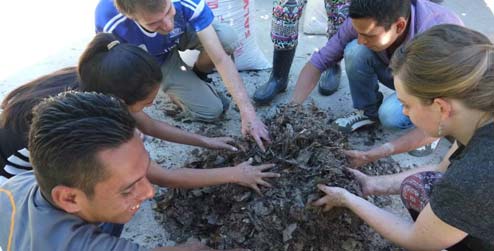In a previous team blog, we spoke about micro-organism soup (not the scientific name). This yeast-smelling concoction has been a recurring theme during our agricultural activities and this week we were taught how to create the base for the solution.
This product is a very economical option for small-scale farmers and is an environmentally friendly alternative to chemical fertilisers. Using the techniques promoted by Red COMAL - our partner organisation, the finished micro-organism brew is applied to crops alongside a natural, organic fertiliser that we also learned how to produce this week.
So, how does one go about creating a giant micro-organism stock cube?
Step 1
Collect some rich, decomposing leaf litter/forest floor material. We used four large sacks of the stuff.
 Step 2
Step 2
Tip out one sack of organic material, get down on hands and knees and start sifting. The organic “gold” we seek is the material already undergoing the process of decomposition; that’s already home to colonies of bacteria and fungi. Remove any healthy material such as green leaves, seeds, live roots and hard twigs.
Step 3
Add grain and sugar. Once the decomposing material has been isolated, the micro-organisms need food. For this purpose we use grain (wheat or rice semolina) at a ratio of about one part grain to two parts organic material. For further microbial sustenance, a sugar solution is added to the giant, doughy mixture. This ideal solution is molasses, but it can alternatively be honey or dark sugar melted in water. As the grain is tossed into the organic matter (on the ground, using elbow grease), this solution is sprinkled over the pile to keep it moist. The ideal texture is firm when compressed, but still crumbly and not damp.
Step 4
Dump out another sack and repeat steps 1-3 until all organic material has been combined with grain and sugar and mixed together.
 Step 5
Step 5
Compact the mixture into a barrel. The enriched organic material must now be compressed little by little into an airtight barrel and left in a cool, dark place to ferment for one month.
Et voilà! We have one giant micro-organism stock cube for future dilution. All for only the price of a bag of semolina, a bottle of molasses and a barrel. The solution is applied with a sprayer direct onto the plant, just as artificial fertilisers would be.The difference is that our natural spray benefits the crop without making its presence felt. It gets on with its job quietly without the threat of water pollution, it enhances rather than depresses biodiversity.
And it (sort of) smells like bread!
Written by ICS volunteer Ellen Shields



